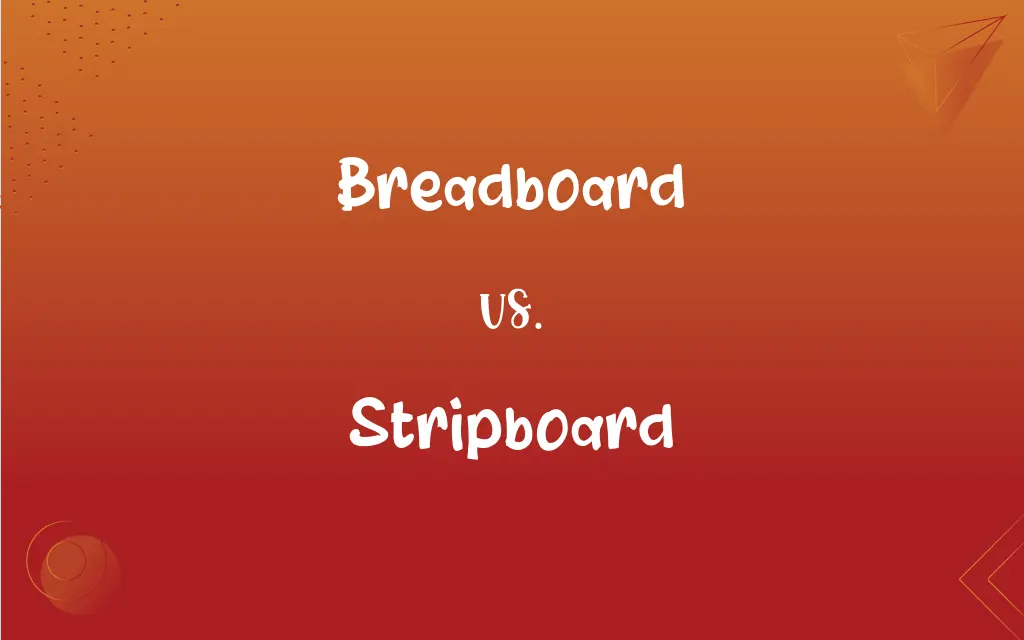Breadboard vs. Stripboard: What's the Difference?
By Aimie Carlson & Janet White || Updated on May 23, 2024
A breadboard is a reusable platform for prototyping electronic circuits without soldering, while a stripboard is a perforated board with fixed copper strips used for soldering permanent circuits.

Key Differences
A breadboard is a prototyping tool that allows for the easy assembly and testing of electronic circuits without soldering. It consists of a plastic board with a grid of interconnected holes into which electronic components and wires can be inserted. On the other hand, a stripboard is a type of prototyping board designed for creating permanent soldered circuits. It is a flat, rigid board with a grid of holes, each surrounded by a copper pad or strip on one side.
Breadboards are favored in educational settings and initial design phases due to their flexibility and reusability. They allow quick modifications and troubleshooting without the need for soldering, making them perfect for iterative testing. Stripboards, on the other hand, are chosen when a more permanent and reliable solution is needed. Once the circuit design is finalized on a breadboard, it can be transferred to a stripboard for soldering, ensuring robust and stable connections.
In terms of complexity, breadboards support rapid changes and debugging, making them ideal for beginners and those in the prototyping phase. Stripboards require soldering skills and a clear design plan, as changes are more challenging once components are soldered.
Breadboards offer flexibility with no permanent changes to components, which can be reused in different projects. Stripboards provide a more professional and durable finish, suitable for final products and demonstrations.
Comparison Chart
Reusability
Reusable, no soldering
Not reusable, requires soldering
ADVERTISEMENT
Assembly Method
Components inserted into holes
Components soldered onto copper strips
Ideal Use
Prototyping and experimentation
Permanent and stable circuit assemblies
Complexity
Easy to modify and debug
Requires soldering and pre-planned layout
Durability
Temporary setups
Durable and long-term installations
Breadboard and Stripboard Definitions
Breadboard
A plastic board with interconnected holes for component insertion.
Components were easily rearranged on the breadboard for testing.
ADVERTISEMENT
Stripboard
A rigid board for durable and long-lasting electronic projects.
The stripboard ensured the circuit remained intact during usage.
Breadboard
A tool for temporary and flexible electronic circuit assembly.
The breadboard allowed quick adjustments to the sensor configuration.
Stripboard
Used for creating permanent and soldered circuit connections.
Each component was carefully soldered onto the stripboard.
Breadboard
A reusable board for prototyping electronic circuits without soldering.
The engineer used a breadboard to test the new circuit design.
Stripboard
A perforated board with copper strips for soldering electronic components.
The final circuit was assembled on a stripboard for stability.
Breadboard
Ideal for experimentation and iterative design processes.
She used the breadboard to rapidly prototype different LED configurations.
Stripboard
Suitable for final products and professional presentations.
The project was transferred from a breadboard to a stripboard for a polished finish.
Breadboard
Commonly used in educational and development environments.
The students built their first circuits on breadboards in the lab.
Stripboard
Requires soldering and a pre-planned component layout.
He meticulously soldered the components onto the stripboard.
Breadboard
A board on which bread is sliced or dough is kneaded.
Stripboard
A type of prototyping board characterized by a ⅒″ regular rectangular grid of holes, with wide parallel strips of copper cladding running in one direction all the way across one side of the board.
Breadboard
An experimental model, especially of an electric circuit; a prototype.
Stripboard
A piece of given dimensions of such a prototyping board.
Breadboard
A thin, blank, often white board on which a prototype circuit with numerous connections for circuit elements is constructed.
Breadboard
To construct an experimental model of (an electric circuit, for example).
Breadboard
A cutting board, especially for cutting bread.
Breadboard
A pull-out cutting board underneath a counter, found in many kitchens.
Breadboard
(electronics) A device used to build a (usually temporary) prototype of an electronic circuit and for experimenting with circuit designs. Both solder and solderless versions are available; the solderless type are easily reusable.
Breadboard
(transitive) To set up (an electronic device) on a breadboard.
Breadboard
A wooden or plastic board on which dough is kneaded or bread is sliced
FAQs
What is a stripboard used for?
A stripboard is used for creating permanent, soldered electronic circuits.
Do breadboards require soldering?
No, breadboards do not require soldering.
Can breadboards be used for permanent circuits?
No, breadboards are intended for temporary setups and experimentation.
What is a breadboard used for?
A breadboard is used for prototyping and testing electronic circuits without soldering.
Which is better for beginners, breadboard or stripboard?
Breadboards are better for beginners due to their ease of use and flexibility.
Can you reuse a stripboard?
No, stripboards are typically not reusable once components are soldered in place.
Can stripboards be used for prototyping?
While possible, stripboards are less ideal for prototyping due to the need for soldering.
How are components connected on a breadboard?
Components are connected through a grid of interconnected holes.
What types of projects are best for stripboards?
Stripboards are best for permanent installations and final product assemblies.
Can you reuse a breadboard?
Yes, breadboards are reusable and allow components to be easily inserted and removed.
Do stripboards require soldering?
Yes, stripboards require soldering to connect components.
Can stripboards handle high-frequency signals?
Stripboards can handle high-frequency signals better due to stable soldered connections.
Are breadboards good for circuit debugging?
Yes, breadboards are excellent for circuit debugging and making quick changes.
Which is more durable, breadboard or stripboard?
Stripboards are more durable for long-term use since components are soldered in place.
How are components connected on a stripboard?
Components are connected by soldering them to copper strips or pads.
Can breadboards handle high-frequency signals?
Breadboards may not be suitable for high-frequency signals due to potential interference.
What tools are needed for using a breadboard?
No special tools are needed, just the components and connecting wires.
What types of projects are best for breadboards?
Breadboards are best for prototyping, experimentation, and educational projects.
Are stripboards good for circuit debugging?
No, once components are soldered, changes on a stripboard are difficult.
What tools are needed for using a stripboard?
A soldering iron, solder, and basic hand tools are needed for using a stripboard.
About Author
Written by
Aimie CarlsonAimie Carlson, holding a master's degree in English literature, is a fervent English language enthusiast. She lends her writing talents to Difference Wiki, a prominent website that specializes in comparisons, offering readers insightful analyses that both captivate and inform.
Co-written by
Janet WhiteJanet White has been an esteemed writer and blogger for Difference Wiki. Holding a Master's degree in Science and Medical Journalism from the prestigious Boston University, she has consistently demonstrated her expertise and passion for her field. When she's not immersed in her work, Janet relishes her time exercising, delving into a good book, and cherishing moments with friends and family.
































































